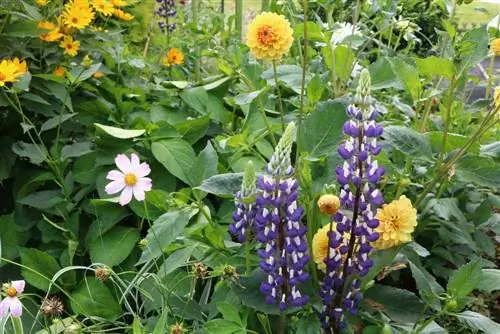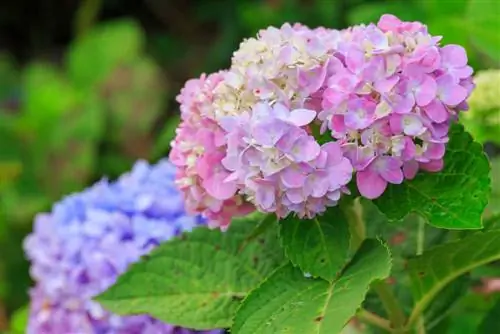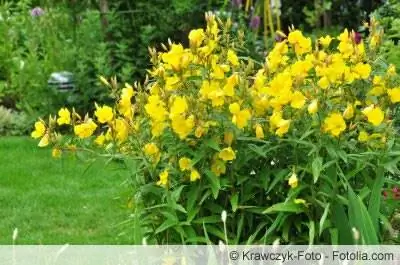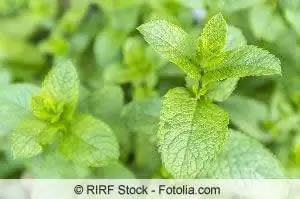- Author admin [email protected].
- Public 2023-12-17 03:39.
- Last modified 2025-01-24 12:45.
Around 300 species belong to the mullein genus (Verbascum), all of which have a taproot to penetrate into water-containing soil layers. Most mulleins are biennial or perennial, depending on the variety. The plants are undemanding and delight every hobby gardener with their colorful, majestic white, yellow, pink, red or violet flower candles. Verbascum looks beautiful in gravel or perennial gardens and self-sows there. The leaves have a dense felt of hair that protects the plant from evaporation and snails.
Plants
The mullein is preferably planted in autumn or late spring. To do this, dig an appropriately sized planting hole, depending on the root ball of the plant. A rule of thumb is that the planting hole should be about twice as wide and twice as deep as the size of the root ball. For small seedlings, the planting hole does not have to be very large. Add a loose garden soil-compost mixture to the planting hole and plant the plant. Then press the root ball well and slurry it with water. Depending on the height of the mullein variety, the distance to the next plant should be between 50 and 100 cm.
Tip:
A thin layer of mulch prevents the soil surface from drying out.
Location
The mullein likes a sunny, warm location, as it can best develop its colorful flower candles in the sun. However, some Verbascum varieties also feel comfortable in partial shade. With its impressive size, the mullein also looks attractive in front of fences or house walls, and cannot be easily bent by the wind. Always tie mulleins that are taller than 1 m securely to a planting aid.
Tip:
The mullein should not be placed in the shade, as it hardly produces any flowers there and does not reach its full size.
Floor
mulleins get along well with calcareous, sandy and poor garden soils as well as in a gravel bed. Depending on their size, some types of Verbascum can also be planted in a container. Here, for example, the large-flowered and tall species look very beautiful if you place them in the middle of the planter and combine them with slightly hanging flowering or decorative foliage plants that you plant on the edge of the pot. Conventional potting soil is sufficient for planting in pots.
Pouring
The mullein normally copes with drought, but its root ball should never dry out. Therefore, water the plant during long periods of heat. The root ball also cannot tolerate the opposite of severe drought. Therefore, you should always make sure that the plant is not in waterlogged substrate.
Fertilize
You can avoid using commercial fertilizer for all Verbascum varieties if you enrich the soil with compost in spring and during the flowering phase. The same is true with the mulleins in the bucket. Plant teas, such as those from nettle, which serve as a natural fertilizer, are also helpful.
Cutting
You don't necessarily have to cut back the mullein unless you want to encourage a second bloom in the same year. To do this, cut the plant down to its rosette on the ground. Some verbascum varieties die after flowering, so they can be added to the compost heap after harvesting their seeds if you want to sow next year's plants. If you want to offer the tits in your garden a few treats in autumn and winter, leave the mullein seed heads standing. Other local birds also like to feast on it.
Wintering
Many of the perennial Verbascum varieties are hardy and therefore do not require winter protection. In harsh and cold regions, however, it is advisable to apply a protective cover of leaves, bark mulch or brushwood to the rosette of leaves. If you keep the mullein in the pot, place the pot in a sheltered place near the house or on the terrace and wrap it well with brushwood, fleece or jute. It is also possible to overwinter the mullein in the winter garden if the location is not too warm.
Propagate
All types of mullein can be propagated from seeds or root cuttings.
Seeds
All Verbascum varieties belong to the so-called cold germinators. This means that they need winter temperatures to germinate. It is therefore advisable to sow the seeds in a sowing bed outdoors in autumn. If you don't want to go to the trouble, you can leave the seed heads and wait until spring until the self-sown plants appear in the garden. You can simply dig these out of the ground and plant them at their destination. Sowing on the windowsill is also possible, but is not always successful because the mulleins are cold germinators. Therefore, place your seed trays in a cool to cold location.
Root cuttings
- cutting root cuttings in autumn
- Root pieces only from strong plants
- a root piece should only be 10 cm long
- cut the bottom end diagonally
- Place root piece in humus-rich substrate
- top end flush with the surface of the plant substrate
- sprinkle some loose soil over it
- Overwinter the root cutting in a frost-free place
- ideal: bright room in the house, garage or greenhouse
- don't forget to keep the substrate moist
- plant next spring after the last frost
Diseases and pests
Since mulleins are usually very resilient plants, they are rarely affected by pathogens or harmful insects. What can happen from time to time is the formation of root rot. This is due to waterlogging. Therefore, make sure that there is no waterlogging at the location of the mullein.
Sometimes the mullein is attacked by the caterpillars of the mullein monk. It is a butterfly from the family of owls. The mullein usually has very large leaves in its rosettes that the caterpillars can feast on, so that hardly any other parts of the plant are eaten. But the plants quickly sprout again. However, it is advisable to collect the caterpillars from young plants so that they do not fall completely victim.
Conclusion of the editors
All types of mullein, whether biennial or hardy, thrive best on sandy, gravelly and calcareous soils and love a sunny location. For example, they are very suitable for perennial and gravel gardens. Although they require little care, the mulleins thrive magnificently and delight the hobby gardener with wonderful inflorescences that appear in white, red, purple, blue, yellow or pink, depending on the variety.
What you should know about mullein in brief
Profile
- Species/Family: Perennial; belongs to the figwort family (Scrophulariaceae)
- Flowering period: July to September with candle-shaped inflorescences consisting also of a multitude of phlox-like, cup-shaped flowers in yellow, white, orange, violet or pink; blooms from below
- Foliage: egg-shaped, partly very large leaves in green or white-green hairy
- Growth: strong, upright flower stalks come from basal leaf rosettes; spreads widely through insemination
- Height: 50 to 180 cm
- Location: sunny to partially shaded; sandy, preferably stony and permeable soil
- Planting time: any time as long as the ground is not frozen
- Pruning: strong pruning at the end of winter
- Partner: beautiful as a solitaire; best with high speedwell, catnip, lavender, sage, prickly nut
- Propagation: Divide in spring before new growth or in autumn cut approx. 5 cm long root cuttings, which root quickly when planted horizontally; Seeds can be collected
- Care: water when dry; Fertilization in spring, but not necessary
- Wintering: hardy
Special features
- likes to stay in the same place for years
- very popular with bees
- good cut flower
mullein species
- Chaix Mullein (Verbascum chaixii): Height 100 cm; oval medium green leaves that reach a length of up to 25 cm; is native to Europe; is under nature protection
- Yellow silky mullein (Verbascum bombyciferum): height 180 cm; Leaves white tomentose hairy, shimmering silver
- (Verbascum phoeniceum): height 60 cm; blooms from May to June; sunny location is preferred
Varieties (selection)
- `Album: Chaix Mullein. Striking white flowers with contrasting purple stamens. Requires sunny location
- `Honey Dijon: Newer variety. Height 50-60 cm. Blooms dark copper-orange from July to September. Also tolerates partial shade well
- `Jackie: Chaix Mullein. Height 40 cm. Modern perennial hybrid variety with large flowers in salmon pink. Requires sunny location
- `Lavender Lass: Newer variety. Height 50-60 cm. Blooms pure purple from July to September. Also tolerates partial shade well
- `Lemon Sorbet: Newer variety. Height 50-60 cm. Blooms from July to September in lemon yellow with a reddish center. Also tolerates partial shade well
- `Pink Domino: Chaix Mullein. Persistent modern hybrid variety that impresses with large salmon pink flowers. Requires sunny location
- `Pink petticoats: height 50 cm. Blooms in June, after pruning after flowering a second flowering occurs in August. Flowers are light pink to pink and are very dense. Requires a purely sunny location






